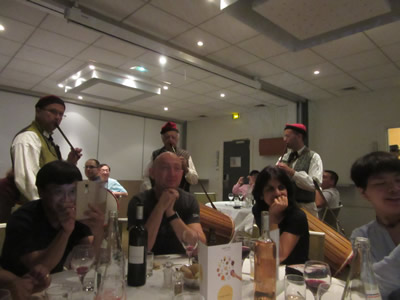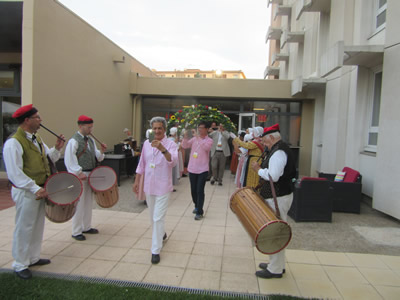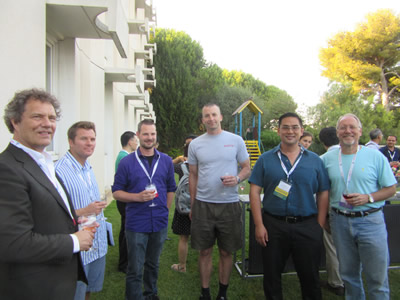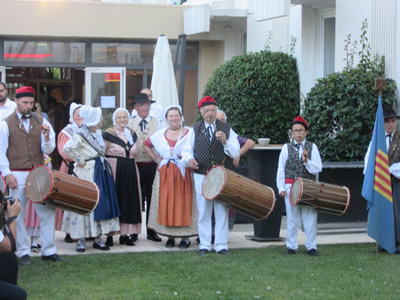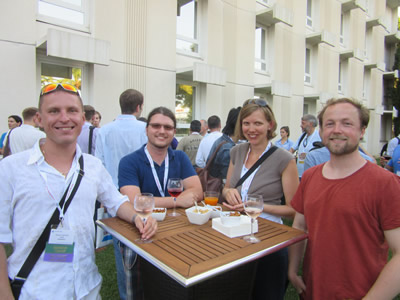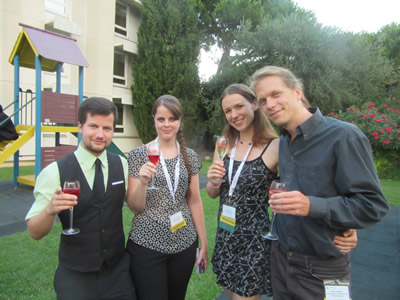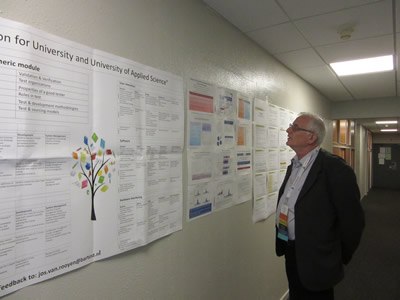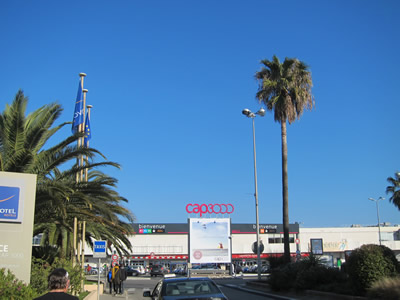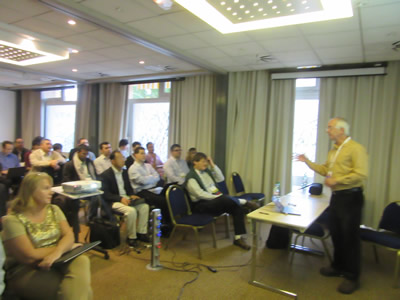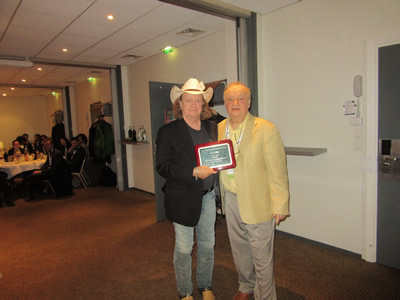VISUAL 2021 - The Sixth International Conference on Applications and Systems of Visual Paradigms
July 18, 2021 - July 22, 2021
VISUAL 2021: Call for Papers
Onsite and Online Options: In order to accommodate a large number of situations, we are offering the option for either physical presence or virtual participation (pdf slides or pre-recorded videos).
Visual paradigms were developed on the basis of understanding the brain’s and eye’s functions. They spread over computation, environment representation, autonomous devices, data presentation, and software/hardware approaches. The advent of Big Data, high speed images/camera, complexity and ubiquity of applications and services raises several requests on integrating visual-based solutions in cross-domain applications.
VISUAL 2021, The Sixth International Conference on Applications and Systems of Visual Paradigms, continues the inaugural event in putting together complementary domains were visual approaches are considered in a synergetic view.
We solicit both academic, research, and industrial contributions. We welcome technical papers presenting research and practical results, position papers addressing the pros and cons of specific proposals, such as those being discussed in the standard fora or in industry consortia, survey papers addressing the key problems and solutions on any of the above topics short papers on work in progress, and panel proposals.
Industrial presentations are not subject to the format and content constraints of regular submissions. We expect short and long presentations that express industrial position and status.
Tutorials on specific related topics and panels on challenging areas are encouraged.
The topics suggested by the conference can be discussed in term of concepts, state of the art, research, standards, implementations, running experiments, applications, and industrial case studies. Authors are invited to submit complete unpublished papers, which are not under review in any other conference or journal in the following, but not limited to, topic areas.
All topics and submission formats are open to both research and industry contributions.
VISUAL 2021 conference tracks:
Hot topics on visualization systems and technologies
General: Eye tracking for personal visual analytics; Volume analysis and classification; Biomedical visualization; Multi-modal and multi-field visualization; Data-driven evaluation of visual quality measures; Volume rendering; High-dimensional visualization; Geospatial visualization; Flow visualization; Geospatial and large scale visualization; Landscapes and eco-systems visualization; Shape and reflectance; Flow and motion; Recognition and tracking; 3D representations; 3D facial analysis and retrieval; Knowledge-based 3D object retrieval; Multi-view reconstruction; Dynamic shape measurement and analysis; Surface reconstruction
Techniques: Analysis of visual arts collections; Information visualization; Information visualization sensemaking; Visual analytics; Interactive visual profiling; Activity recognition by visual analytics; Visual causality analysis; Interactive visualization; Visual correlation analysis; Sonification
Services: Urban visual analytics; Inheritage building modeling; Digital humanity: visualization of historical/cultural content; Traffic flow visualization; Visual analysis of volume data; Visual exploration of data sets; Visualization of biomedical images; Visualizing patterns of temporal evolution; Interactive visual search; Real-time uncertainty visualization; Personal visualization; Personal visual analytics
Visual Computation and Modeling
Computer Vision; Computer Graphics; Computer Animation; Visual Patterns; Visual Perception; Virtual Reality and Augmented Virtual Reality; Augmented Desktop; Video and Image Retrieval and Processing; Recognizing Image Visual Context; Medial Models for Vision; Multi-sensory Processing in Humans and Machines; Shapes Computational Approaches
Eye Visual Perception Mechanisms
Visual Neuroscience; Eye Movement Analysis and Illusions; Perception of Gaze Direction ; Reflexive Attentional Shift; ole of Orientation and Position in Shape Perception; Signal and Noise Orientations; Eye-movement Patterns; Visio-tactile Contributions to the Perception of Naturalness
Visual Robotics
Perceptual Robotics; Spatio-temporal Sensing; Coding and Decoding Strategies for Depth Perception; Perceive 3-D Structure of Objects; Depth Perception in Depth-fused 3-D (DFD); Visual acuity; Comparing Audiovisual Distance Perception in `Real' and `Virtual' Environments; Inferred Motion Perception
Environment Visual Modeling
Applied Computer Vision; 2D/3D Visualization; Shape Representation and Processing; Haptic and Vision Perception; Frameworks for Gaze Guidance; Human Visual Communication; Visual Image Reconstruction from Human Brain Activity; Fast and Robust Decoding of Visual Information
Visual Approaches for Software/Hardware
Visual Software and Hardware Languages and Methodologies; Visualization of Systems Integration and Design; Visual Programming Paradigms; Visualizing Models and Meta-Models; Software Quality Visualization; Visual Abstractions; Visual Process Mining; Visualizing Concurrent Programs; Code and Programs Visual Exploration/Verification; Visualizing Big Data Links; Web-based Data Visualization; Visualizing Missing Information; Visualizing hidden relationships; Comparative Visualizations; Visualization for Program Comprehension and Maintenance; Trace Visualization; Thread Interleaving Visualization; Interface Animation
Visual Services and Applications
Visualizing Mobility; Visual Analytics; Visual Games; Visual Reasoning Systems; Visualizing Manufacturing Factories; Visualizing Nanoscale Neuronal Models; Visual Forensic Analytics; Visual Analytics of Environmental Metrics (Earth, Oceans, Atmosphere, etc.); Visualizing Social Networks and Communities; Business Intelligence
Deadlines:
Submission | May 11, 2021 |
Notification | May 31, 2021 |
Registration | Jun 13, 2021 |
Camera ready | Jun 16, 2021 |
Deadlines differ for special tracks. Please consult the conference home page for special tracks Call for Papers (if any).
INSTRUCTION FOR THE AUTHORS
Authors of selected papers will be invited to submit extended versions to one of the IARIA Journals.
Publisher: XPS (Xpert Publishing Services)
Archived: ThinkMindTM Digital Library (free access)
Prints available at Curran Associates, Inc.
How to submit to appropriate indexes.
Only .pdf or .doc files will be accepted for paper submission. All received submissions will be acknowledged via an automated system.
Contribution types
- regular papers [in the proceedings, digital library]
- short papers (work in progress) [in the proceedings, digital library]
- ideas: two pages [in the proceedings, digital library]
- extended abstracts: two pages [in the proceedings, digital library]
- posters: two pages [in the proceedings, digital library]
- posters: slide only [slide-deck posted on www.iaria.org]
- presentations: slide only [slide-deck posted on www.iaria.org]
- demos: two pages [posted on www.iaria.org]
FORMATS
Only .pdf or .doc files will be accepted for paper submission. All received submissions will be acknowledged via an automated system.
Final author manuscripts will be 8.5" x 11", not exceeding 6 pages; max 4 extra pages allowed at additional cost.
Helpful information for paper formatting for MS Word can be found here.
There is a community provided LaTeX template: the CTAN package iaria (with full IARIA formatting rules, including IARIA citation style, but for providing citation style it is tightly bound to pdflatex+biblatex+biber). In addition, there is also iaria-lite (not bound to pdflatex+biblatex+biber, but compatible with any TeX stack; thus, it cannot provide the IARIA citation formattings, but only the titlepage and content-related IARIA formatting rules). Based on the iaria package, there is a minimal working example as Overleaf template. When you are using the LaTeX templates, please still adhere to the additional editorial rules.
Slides-based contributions can use the corporate/university format and style.
Your paper should also comply with the additional editorial rules.
Once you receive the notification of contribution acceptance, you will be provided by the publisher an online author kit with all the steps an author needs to follow to submit the final version. The author kits URL will be included in the letter of acceptance.
We would recommend that you should not use too many extra pages, even if you can afford the extra fees. No more than 2 contributions per event are recommended, as each contribution must be separately registered and paid for. At least one author of each accepted paper must register to ensure that the paper will be included in the conference proceedings and in the digital library, or posted on the www.iaria.org (for slide-based contributions).
CONTRIBUTION TYPE
Regular Papers (up to 6-10 page article -6 pages covered the by regular registration; max 4 extra pages allowed at additional cost- ) (oral presentation)
These contributions could be academic or industrial research, survey, white, implementation-oriented, architecture-oriented, white papers, etc. They will be included in the proceedings, posted in the free-access ThinkMind digital library and sent for indexing. Please submit the contributions following the instructions for the regular submissions using the "Submit a Paper" button and selecting the appropriate contribution type. 12-14 presentation slides are suggested.
Short papers (work in progress) (up to 4 pages long) (oral presentation)
Work-in-progress contributions are welcome. These contributions represent partial achievements of longer-term projects. They could be academic or industrial research, survey, white, implementation-oriented, architecture-oriented, white papers, etc. Please submit the contributions following the instructions for the regular submissions using the "Submit a Paper" button and selecting the contribution type as work in progress. Contributors must follow the conference deadlines, describing early research and novel skeleton ideas in the areas of the conference topics. The work will be published in the conference proceedings, posted in the free-access ThinkMind digital library and sent for indexing. For more details, see the Work in Progress explanation page. 12-14 presentation slides are suggested.
Ideas contributions (2 pages long) (oral presentation)
This category is dedicated to new ideas in their very early stage. Idea contributions are expression of yet to be developed approaches, with pros/cons, not yet consolidated. Ideas contributions are intended for a debate and audience feedback. Please submit the contributions following the instructions for the regular submissions using the "Submit a Paper" button and selecting the contribution type as Idea. Contributors must follow the conference deadlines, describing early research and novel skeleton ideas in the areas of the conference topics. The work will be published in the conference proceedings, posted in the free-access ThinkMind digital library and sent for indexing. For more details, see the Ideas explanation page. 12-14 presentation slides are suggested.
Extended abstracts (2 pages long) (oral presentation)
Extended abstracts summarize a long potential publication with noticeable results. It is intended for sharing yet to be written, or further on intended for a journal publication. Please submit the contributions following the instructions for the regular submissions using the "Submit a Paper" button and selecting the contribution type as Extended abstract. Contributors must follow the conference deadlines, describing early research and novel skeleton ideas in the areas of the conference topics. The work will be published in the conference proceedings, posted in the free-access ThinkMind digital library and sent for indexing. 12-14 presentation slides are suggested.
Posters (paper-based, two pages long) (oral presentation)
Posters are intended for ongoing research projects, concrete realizations, or industrial applications/projects presentations. The poster may be presented during sessions reserved for posters, or mixed with presentation of articles of similar topic. A two-page paper summarizes a presentation intended to be a POSTER. This allows an author to summarize a series of results and expose them via a big number of figures, graphics and tables. Please submit the contributions following the instructions for the regular submissions using the "Submit a Paper" button and selecting the contribution type as Poster Two Pages. Contributors must follow the conference deadlines, describing early research and novel skeleton ideas in the areas of the conference topics. The work will be published in the conference proceedings, posted in the free-access ThinkMind digital library and sent for indexing. 8-10 presentation slides are suggested. Also a big Poster is suitable, used for live discussions with the attendees, in addition to the oral presentation.
Posters (slide-based, only) (oral presentation)
Posters are intended for ongoing research projects, concrete realizations, or industrial applications/projects presentations. The poster may be presented during sessions reserved for posters, or mixed with presentation of articles of similar topic. The slides must have comprehensive comments. This type of contribution only requires a 8-10 slide-deck. Please submit the contributions following the instructions for the regular submissions using the "Submit a Paper" button and selecting the contribution type as Poster (slide-only). The slide-deck will be posted, post-event, on www.iaria.org.
8-10 presentation slides are suggested. Also a big Poster is suitable, used for live discussions with the attendees, additionally to the oral presentation.
Presentations (slide-based, only) (oral presentation)
These contributions represent technical marketing/industrial/business/positioning presentations. This type of contribution only requires a 12-14 slide-deck. Please submit the contributions following the submission instructions by using the "Submit a Paper" button and selecting the contribution type as Presentation (slide-only). The slide-deck will be posted, post-event, on www.iaria.org.
12-14 presentation slides are suggested.
Demos (two pages) [posted on www.iaria.org]
Demos represent special contributions where a tool, an implementation of an application, or a freshly implemented system is presented in its alfa/beta version. It might also be intended for thsoe new application to gather the attendee opinion. A two-page summary for a demo is intended to be. It would be scheduled in special time spots, to ensure a maximum attendance from the participants. Please submit the contributions following the submission instructions by using the "Submit a Paper" button and selecting the contribution type as Demos. The Demos paper will be posted, post-event, on www.iaria.org.
Tutorial proposals
Tutorials provide overviews of current high interest topics. Proposals should be for 2-3 hour long. Proposals must contain the title, the summary of the content, and the biography of the presenter(s). The tutorial slide decks will be posted on the IARIA site.
Please send your proposals to tutorial proposal
Panel proposals
The organizers encourage scientists and industry leaders to organize dedicated panels dealing with controversial and challenging topics and paradigms. Panel moderators are asked to identify their guests and manage that their appropriate talk supports timely reach our deadlines. Moderators must specifically submit an official proposal, indicating their background, panelist names, their affiliation, the topic of the panel, as well as short biographies. The panel slide deck will be posted on the IARIA site.
Please send your proposals to panel proposal




